di Marta Lock
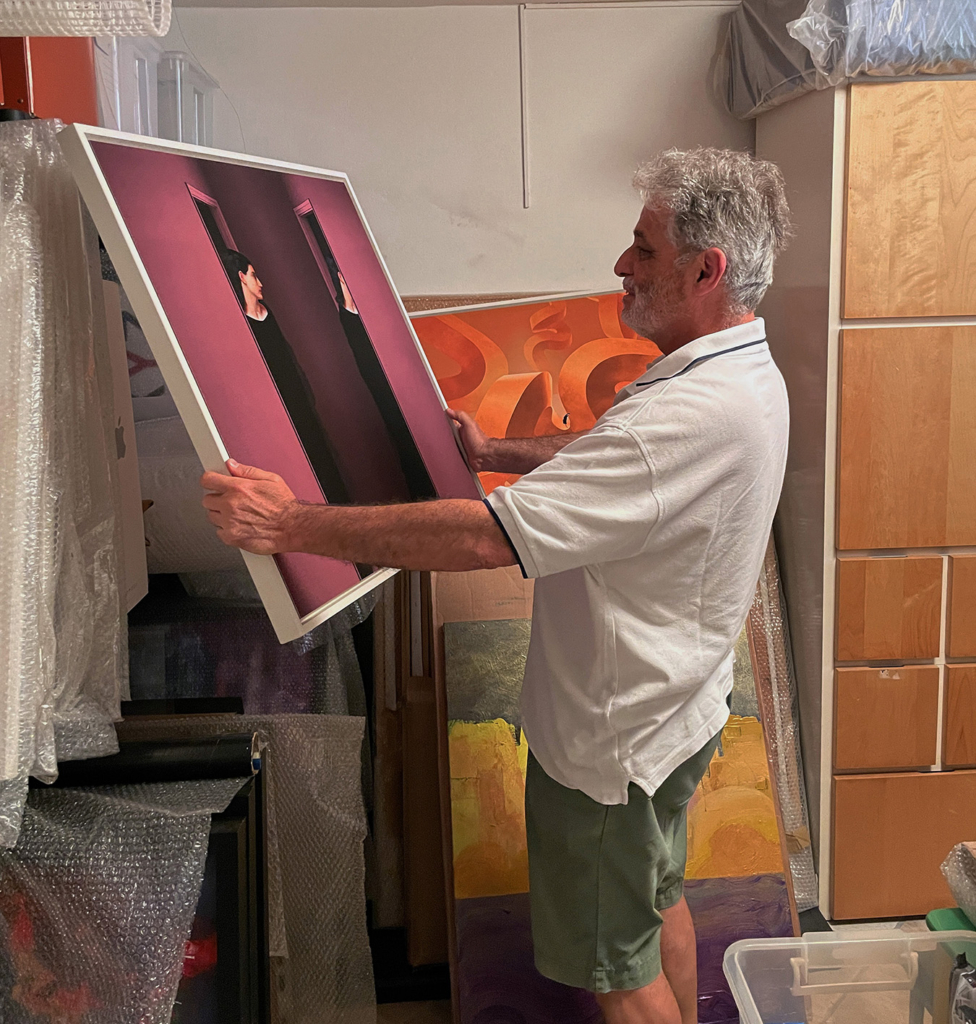
Essendosi formato all’Accademia di Belle Arti di Brera, Piero Campanini non poteva non intraprendere un cammino professionale che gli avrebbe permesso di esprimere quella creatività innata che doveva contraddistinguere la sua vita; inizia a muovere i primi passi nel mondo del lavoro come disegnatore e successivamente, nella Milano da bere dei fantastici anni Ottanta, nella pubblicità. Il suo talento e la sua competenza emersero ben presto consentendogli di affermarsi nel settore dell’advertising, dove ha ricoperto anche il ruolo di art director. La sua dinamicità professionale aveva però bisogno di andare oltre, di creare qualcosa di proprio così nel 1990 fonda la sua boutique creativa, che si occupava prevalentemente di creatività in campo pubblicitario; avere una sua realtà all’interno della quale muoversi gli ha concesso la possibilità di ritagliarsi del tempo per dare sfogo a quell’espressione artistica che aveva bisogno di essere liberata, senza assecondarsi alle esigenze di un committente né di rispondere agli schemi e alle regole del mercato. Cominciò così a lasciarsi andare al suo impulso artistico dando vita a una prima serie di opere e nel contempo dedicandosi anche a un’altra arte, quella scrittoria, a completamento e appagamento della sua natura comunicativa; qualche tempo dopo si interessò all’Arte Digitale inserendola all’interno delle sue opere e generando pertanto una tecnica mista dove l’acrilico diveniva ritocco e personalizzazione dell’elaborazione digitale. La sua inquietudine interiore, quella necessità di domandarsi e trovare risposte agli enigmi della natura umana e alle incertezze del vivere contemporaneo, lo hanno condotto verso il Surrealismo tendente alla Metafisica, poiché il silenzio, la solitudine, i concetti di tempo e spazio, il passato riattualizzato e osservato con lo sguardo del presente, emergono in modo chiaro dalle opere di Piero Campanini, ormai quasi esclusivamente digitali perché è questo il punto di arrivo della sua maturità stilistica. Le sue atmosfere sono suggestive, perché esplorative di tutti quei significati che si nascondono oltre l’apparenza, dietro il visibile che spesso tende solo a costituire un velo, una corazza dentro cui rifugiarsi per proteggersi dalle insicurezze a cui non si trova rassicurazione. Non dà risposte l’artista bensì genera domande e spunti di riflessione, perché consapevole della non esistenza di verità assolute, così come dell’importanza di lasciare liberi gli altri di trovare le proprie soluzioni ai grandi quesiti esistenziali. Nell’opera Tempus Fugit
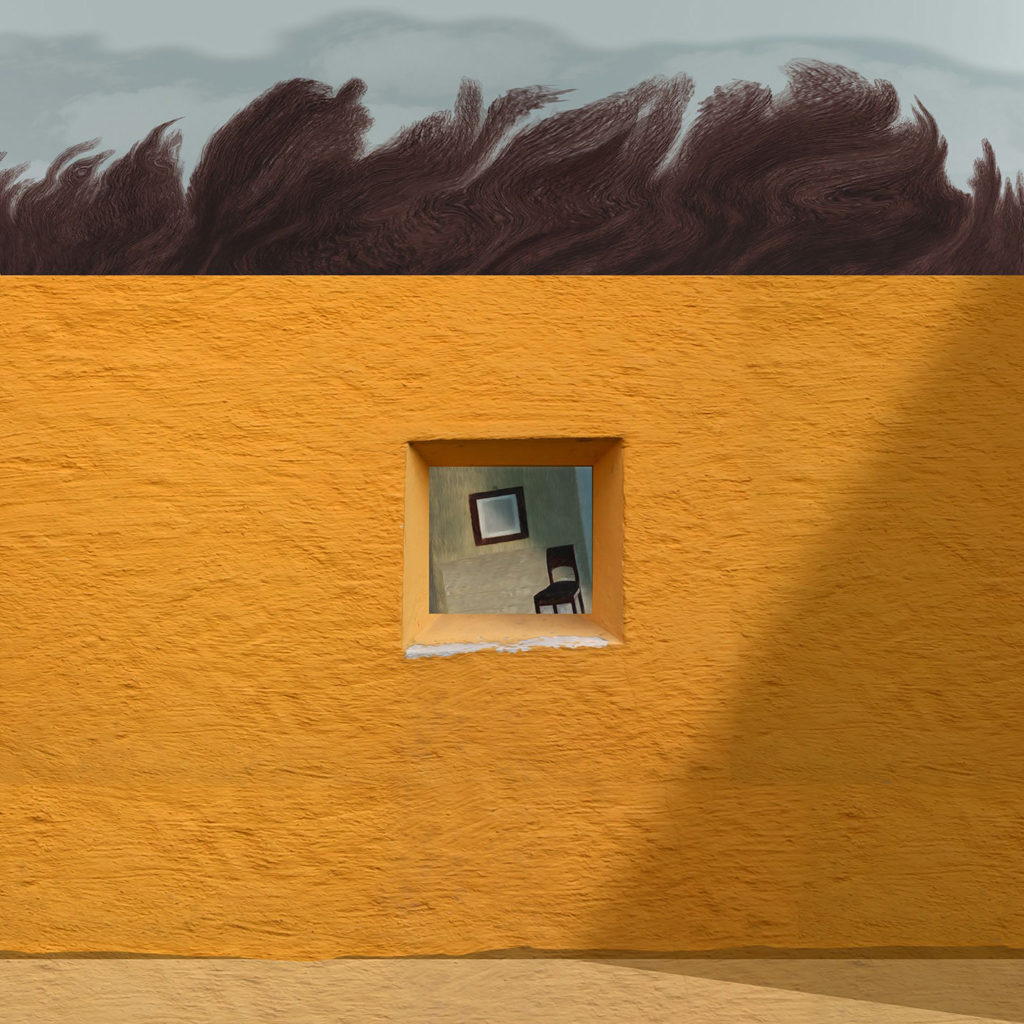
la geometricità sembra voler contenere, o forse sarebbe meglio dire ingabbiare, la natura stessa del tempo, quel suo scorrere inarrestabile malgrado la tendenza dell’essere umano a credere di poter rimandare a suo piacimento scelte e decisioni; la sedia e la cornice storta all’interno del riquadro infondono nell’osservatore la sensazione dell’inutilità di volersi aggrappare a qualcosa che ineluttabilmente è destinato a cambiare, a scorrere, così come indicato dalle chiome sovrastanti il rettangolo esterno che sembrano sottoposte al vento del destino. Nella nuova serie di opere Veneri Millenarie, Campanini celebra le donne che hanno scritto la storia dell’emancipazione femminile, quelle grandi artiste, scienziate, stiliste, rappresentanti della cultura, che sono state in grado di entrare in contrasto con le loro epoche conquistandosi un posto di tutto diritto negli ambienti in cui la presenza della donna era ancora ben lontana dall’essere diffusa; in queste opere, come per esempio Coco Chanel,
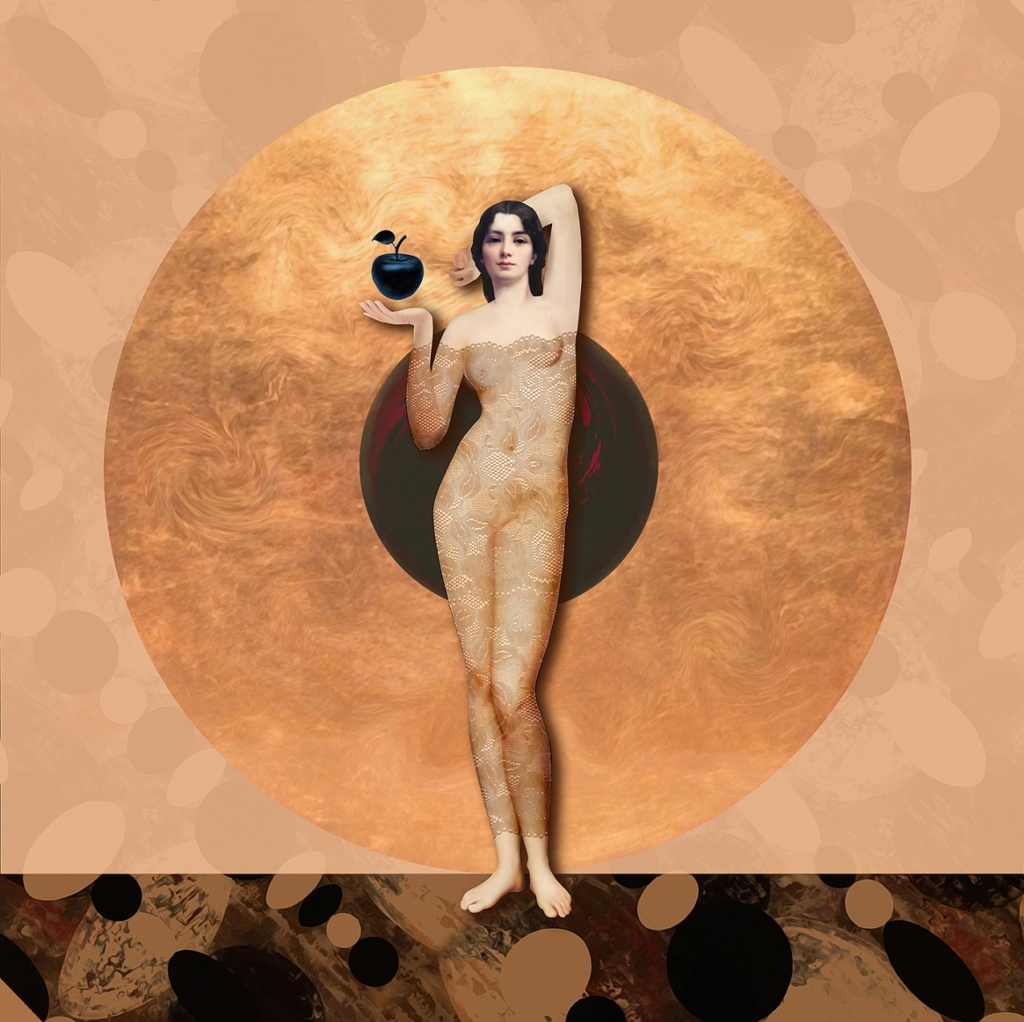
ciò che emerge è la loro individualità, quell’essere sole nel silenzio circostante e nel combattere le loro battaglie che in virtù della loro forza, determinazione, convinzione, sono riuscite a vincere. Andiamo ora a conoscere meglio questo interessante artista che ha fatto della Digital Painting la sua modalità espressiva.
Piero, lei ha lavorato per molti anni nell’ambito della pubblicità, un mondo particolare e spesso considerato effimero eppure dalla sua produzione artistica emerge una grande capacità di approfondimento. Crede che il contatto con un ambiente orientato all’immagine abbia contribuito a spingerla verso una maggiore introspezione e analisi del vivere contemporaneo oppure il suo approccio scaturisce da una sua naturale inclinazione?
Può essere che il risultato finale di un prodotto pubblicitario possa sembrare effimero, d’altronde stiamo parlando di un ambito commerciale dove l’invenzione creativa è solo uno dei molti punti del marketing. Detto questo, per chi si è trovato a lavorare dietro le quinte dell’advertising nel ruolo di Art Director, l’attività ideativa non è affatto effimera, bensì sostanziale. Ci sarebbe molto da raccontare dell’ingegnoso lavoro che si svolge nelle officine della pubblicità, lavoro spesso commentato da sociologi, psicologi e pubblicisti della comunicazione, perché in quei reparti creativi lavorano professionisti di grande talento e talvolta geniali. Questa frequentazione ha sicuramente influito sulla mia persona arricchendola e insegnandole la bontà del pensiero creativo libero ma organizzato, finalizzato al raggiungimento di un qualche obbiettivo. I vari temi che ho affrontato sono stati spesso accompagnati da indagini sul comportamento, sulle preferenze, sulle mode e le mutazioni sociali: una vera miniera di informazioni di ogni genere a ogni profondità. Per rispondere alla domanda se sia stata quella esperienza di lavoro oppure una naturale inclinazione a portarmi a misurarmi con l’arte, direi che la mia è la fortunata coincidenza di entrambe le cose. Concludo col citare uno dei più grandi creativi pubblicitari italiani, Emanuele Pirella, il quale alla domanda in merito a cosa fosse la creatività rispose con semplicità che “la creatività è un’abitudine”. Un’abitudine di cui personalmente non ho mai fatto a meno da disegnatore, pubblicitario e ancor più oggi come artista.

È passato dal disegno al Painting Digitale, come mai ha scelto quest’ultima tecnica nella sua maturità espressiva? Quali sono i limiti e i vantaggi di questo tipo di arte che negli ultimi anni sta conquistando sempre maggiore prestigio e apprezzamento?
Questa domanda si sarebbe potuta porre anche a quegli artisti che agli inizi del secolo scorso si trovarono ad assistere all’avvento della fotografia. Una tecnologia che ai suoi esordi fu ritenuta eretica ma che in breve tempo rese la pittura tradizionale un esercizio anacronistico. Ancora oggi accade che la tecnologia proponga mezzi nuovi e in costante evoluzione, ampliando sempre più i nostri processi cognitivi e creativi, come il caso recente del digitale. Pur avendo iniziato a disegnare con matita, pennarelli, colori a olio e acrilici, pur avendo diffidato all’inizio che un software potesse eguagliare la qualità pittorica, devo ammettere che oggi sono pervenuto a considerare il Digital Painting una risorsa straordinaria e oramai matura per essere compresa nell’ambito della moderna arte contemporanea. I vantaggi del Painting sono innumerevoli per le molte applicazioni e variazioni di stili, la possibilità di contare su infiniti pentimenti e di far prove e rifacimenti senza porsi limiti, infine di calarsi in una dimensione spaziale che risulta essere immensa in quanto astratta e avulsa dalla materia, uno spazio che potremmo definire etereo e dunque affine alla mente umana. Gli svantaggi di questa tecnica sono relativamente pochi, forse di doversi affidare a terzi per la riproduzione finale su un supporto perché il lavoro torni a essere materia, ma lo fanno già altri artisti in molte discipline, pensiamo agli scultori o agli “installatori” a esempio, che affidano il loro progetto creativo ad artigiani in grado di realizzarlo con le materie desiderate. L’unico svantaggio che credo possa forse essere attribuito non solo al Digital Painting ma più in generale a tutto il mondo dell’arte digitale, resta la sua facile riproducibilità, opzione che si contrappone all’unicità del pezzo artistico che tradizionalmente è ciò che gli conferisce valore. A questo proposito un grande artista come Andy Warhol non mi darebbe ragione, avendo fatto della replicabilità il suo quid artistico, tuttavia a scanso di equivoci tutte le mie opere sono certificate e pertanto uniche nel formato originale, proposte talvolta in multipli in formati ridotti e con il limite a non più di cinque, con altrettante certificazioni.
La Metafisica è il linguaggio che la contraddistingue e attraverso il quale comunica le sue riflessioni e punti di vista sui concetti universali su cui l’uomo si è sempre interrogato. Quale messaggio vorrebbe emergesse dalle sue opere? Cosa vorrebbe che giungesse all’osservatore?
Il mio messaggio è relativo alla necessità di conseguire un’ispirazione. Mi spiego meglio: in un tempo di opaca confusione, di virtuose distrazioni di massa e della diffusa inconsapevole astensione dal dover indagare sul significato della propria esistenza, le mie opere provano a offrire lo spunto per ricondurre l’osservatore a ritrovare l’ispirazione perché investighi su di sé. Le mie opere propongono una sorta di quiete interrogativa, invitano ad attivare l’introspezione e dunque a provare a percepire ciò che c’è ma che non sappiamo più ascoltare. Forse la parola che più si avvicina a questo concetto è meditazione. Credo che siamo tutti un po’ alienati dai veri valori della vita, viviamo più come spettatori che come gli attori che in realtà siamo, disorientati dalla paura che ci arriva dall’incognito. Del nostro essere ignoriamo cosa lo muove e il perché esista, cosa sia il nostro io e perché ci rappresenta. Pur di sottrarci dalla questione evitiamo persino di considerare l’inevitabile fine che ci attende e questo, già di per sé, sarebbe un tema sufficiente per imporci una riflessione che ci induca a recuperare al più presto il senso dell’esperienza che chiamiamo vita. Voglio rassicurare di essere rispettoso della fede ma agnostico perché ritengo le religioni con i loro dogmi, partecipi dell’infausta distrazione delle coscienze a cui accennavo prima. Sono un creativo e dunque un credente attivo, non passivo, sono un ricercatore e per questo nelle mie opere s’intravede quanto ho perso o trovato, le mie riflessioni sul Sé e il timore di ciò che ancora non conosco ma cerco nell’oscurità del mondo. Le mie opere parlano della necessità per ognuno di essere un ricercatore libero e indipendente, per fronteggiare i grandi quesiti che porta in sé: Chi sono e perché esisto?
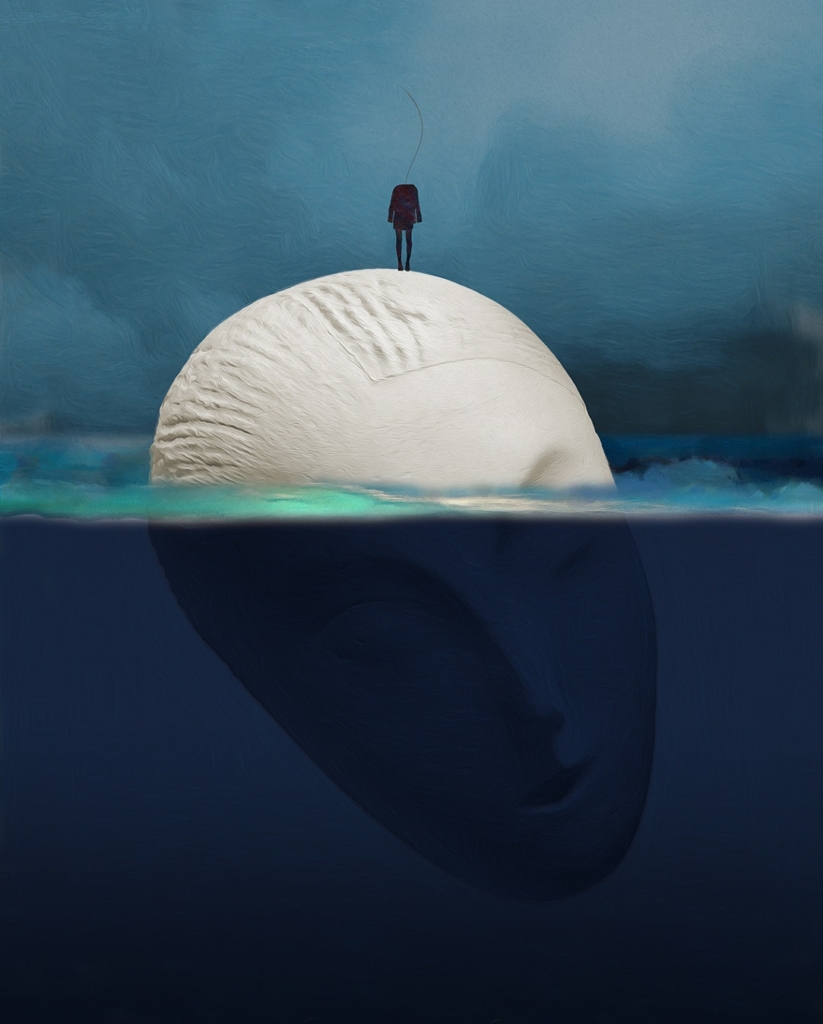
I suoi studi presso l’Accademia di Belle Arti le hanno dato la possibilità di approfondire i grandi maestri del passato; quali sono stati gli artisti che l’hanno ispirata? Quali sente più vicini al suo stile espressivo?
Da studente scrissi una tesi per il mio esame di maturità artistica all’Accademia di Brera, teorizzando un ponte storico tra Francisco Goya, appartenente al Diciottesimo secolo e Gustave Courbet del diciannovesimo, ritenendo Goya il primo reporter artistico dei grandi avvenimenti popolari e drammatici della sua epoca, e il secondo l’ignaro autore della fine di quella stessa epoca, quando il realismo andava esaurendosi per lasciare posto a ciò che in seguito avremmo chiamato arte moderna. Per chi conosce Courbet sa che sto parlando di un pittore la cui maestria ha fatto scuola e che le sue opere suscitarono scandalo nella sua epoca. Non mi riferisco all’Origine du Monde, fin troppo citata, piuttosto alle sue Pommes Rouges, opera considerata precorritrice di ciò che in seguito avrebbe preso forma come Surrealismo e come Metafisica, declinandosi poi nelle varie diramazioni. Tutto questo prese l’avvio proprio grazie alle Pommes Rouges, mele straordinarie e sì realistiche ma fin troppo: troppo rosse, eccentriche, eccessive nel loro essere iperboliche, così smisuratamente mele da trascendere la loro stessa natura e finire col sembrare altro. Credo che sia stato grazie a Courbet se ho iniziato a considerare il soprannaturale nelle cose. Ora, se quanto ho appena ricordato posso ritenere sia stato il mio battesimo concettuale, gli artisti storici dell’arte che in seguito mi colpirono e influenzarono più da vicino furono molti, nomi noti e accessibili ma anche meno noti e inesplicabili come Paul Delvaux, quest’ultimo di certo da me fra i più stimati. Credo che non vi sia miglior parola di impressione, per descrivere cosa provai nell’accostarmi alle sue opere, per il fatto che m’impressionarono davvero. Di Delvaux mi colpì soprattutto la magica presenza femminile archetipa, maestosa e ipnotica che si trova replicata nei suoi paesaggi estatici. Mi commosse il latente erotismo di cui le sue figure sono pregne, m’innamorai della capacità che queste hanno di trasportare oltre l’apparenza fino all’intimo delle cose, al cuore del mistero, muse solenni, indifferenti e impassibili. Nel cercare con umiltà e il dovuto rispetto di emularne il genio, ho provato anch’io a proporre le medesime sensazioni nelle mie opere. Sia inteso che non parlo della tecnica pittorica, che non mi appartiene, ma per il prestito preso dalla sua arte sensitiva, dalle sue atmosfere, da quel suo “impero della donna” come lo definì Delvaux stesso, che oggi tradurremmo in emozionante rappresentazione simbolica dell’animo umano. È l’idea di qualcosa di enigmatico ed eterno, il punto di osservazione da dove gettare lo sguardo oltre la cortina esistenziale verso l’impalpabile mondo platonico dello spirito.
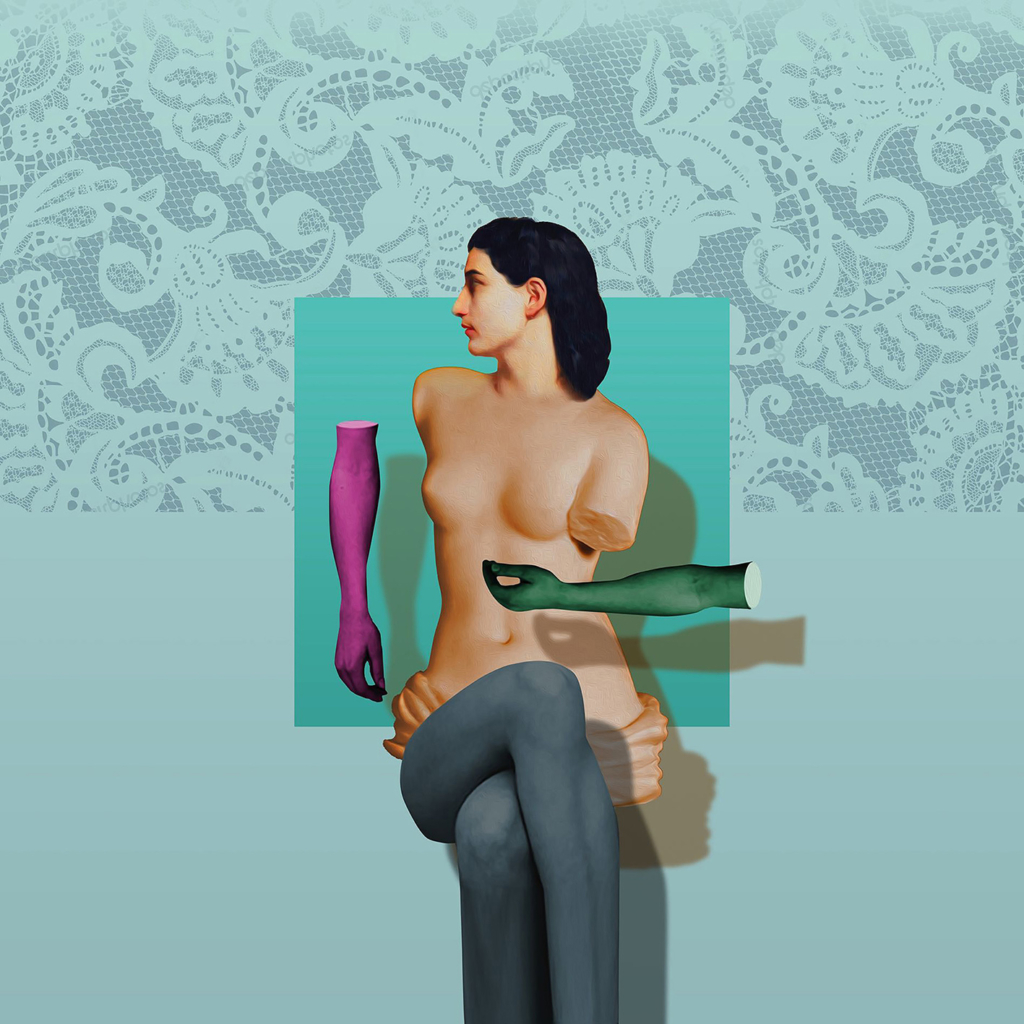
Il suo esordio espositivo è stato con la galleria Bongiovanni di Bologna, ed è poi proseguito fino a portarla a esporre a Madrid. Ci racconta i suoi prossimi progetti?
Molti, tanti, soprattutto ora dopo l’obbligata pausa per il Covid e con la speranza che la guerra in corso non annichilisca ogni cosa. Ho la fortuna di poter partecipare ad alcuni eventi artistici che ritengo importanti perché le mie opere si confrontino con il pubblico. Questo grazie a Made4Art a Milano, all’attività di The Art Company di Como e più recentemente alla Galleria Monat di Madrid. Spero inoltre con il prossimo anno di poter riproporre il progetto “Rigore e Psiche”, un progetto artistico pensato e sviluppato assieme all’amico e artista Paulon, progetto che ritengo importante per il riscontro che ha già avuto e il contributo che raccoglie attraverso il dialogo diretto con la gente. Ho in cantiere altri eventi importanti di cui non sono ancora in grado di parlare, in particolare la serie Vénus Millénaire, una raccolta di ritratti simbolici dedicati a donne che hanno contribuito nella lotta per l’emancipazione femminile, opere che spero trovino al più presto modo di essere esposte.
PIERO CAMPANINI-CONTATTI
Email: contatto@pierocampanini.com
Sito web: https://www.pierocampanini.com/
Facebook: https://www.facebook.com/campaninipiero.art/
Linkedin: https://www.linkedin.com/in/piero-campanini-221a8615/
Instagram: https://www.instagram.com/piero_campanini/
Marta Lock’s interviews:
Piero Campanini, advertising and communication to reach expressive maturity in Digital Painting
Having trained at the Brera Academy of Fine Arts, Piero Campanini could not fail to embark on a professional path that would allow him to express that innate creativity that was to characterise his life. He began to take his first steps in the world of work as a cartoonist and later, in the Milan of the fantastic 1980s, in advertising. His talent and expertise soon emerged, allowing him to establish himself in the advertising sector, where he also held the position of art director. His professional dynamism, however, needed to go further, to create something of his own, so in 1990 he founded his creative boutique, which dealt mainly with creativity in advertising; having his own reality within which to move gave him the opportunity to carve out some time to give vent to that artistic expression that needed to be set free, without pandering to the demands of a client or responding to the schemes and rules of the market. Thus, he began to let go of his artistic impulse, creating a first series of artworks and at the same time dedicating himself to another art, the scriptural one, to complete and satisfy his communicative nature; some time later, he became interested in Digital Art, incorporating it into his artworks and thus generating a mixed technique where acrylic became retouching and customising digital processing. His inner restlessness, that need to ask himself and find answers to the enigmas of human nature and the uncertainties of contemporary life, led him towards Surrealism tending towards Metaphysics, as silence, solitude, the concepts of time and space, the past re-actualised and observed through the eyes of the present, clearly emerge from Piero Campanini’s artworks, now almost exclusively digital because this is the point of arrival of his stylistic maturity. His atmospheres are evocative because they explore all those meanings that are hidden beyond appearance, behind the visible that often tends only to constitute a veil, a shell within which to take refuge to protect oneself from insecurities for which there is no reassurance. The artist does not give answers but rather generates questions and food for thought, because he is aware of the non-existence of absolute truths, as well as the importance of leaving others free to find their own solutions to the great existential questions. In the artwork Tempus Fugit, geometricity seems to want to contain, or perhaps it would be better to say cage, the very nature of time, that unstoppable flow of time despite the tendency of human beings to believe they can postpone choices and decisions at will; the chair and the crooked frame within the frame instil in the observer the feeling of the futility of wanting to cling to something that is ineluctably destined to change, to flow, as indicated by the foliage above the outer rectangle that seems subject to the wind of destiny. In the new series of artworks Vénus Millénarie, Campanini celebrates the women who wrote the history of female emancipation, those great artists, scientists, stylists, representatives of culture, who were able to contrast with their eras by gaining a rightful place in environments where the presence of women was still far from widespread; in these artworks, such as Coco Chanel for example, what emerges is their individuality, that being alone in the surrounding silence and in fighting their battles, which by virtue of their strength, determination, conviction, they managed to win. Let us now get to know better this interesting artist who has made Digital Painting his mode of expression.
Piero, you have worked for many years in the field of advertising, a particular world that is often considered ephemeral, yet your artistic production reveals a great capacity for in-depth study. Do you think that your contact with an image-oriented environment has helped push you towards greater introspection and analysis of contemporary life, or does your approach spring from a natural inclination?
It may be that the end result of an advertising product may seem ephemeral, after all
we are talking about a commercial field where creative invention is only one of the many points of
marketing. That said, for those who have found themselves working behind the scenes in advertising in the role of Art Director, ideational activity is by no means ephemeral, but rather substantial. There would be much to tell about the ingenious work that goes on in the advertising workshops, work that is often commented on by sociologists, psychologists and communication publicists, because very talented and sometimes brilliant professionals work in those creative departments. This frequentation has certainly influenced my person, enriching it and teaching it the goodness of creative thinking free but organised, aimed at achieving some objective. The various topics I dealt with were often accompanied by investigations into behaviour, preferences, trends and social mutations: a veritable mine of information of every kind at every depth. To answer the question of whether it was that work experience or a natural inclination that led me to engage with art, I would say that mine is the fortunate coincidence of both. I would end by quoting one of Italy’s greatest advertising creatives, Emanuele Pirella, who when asked what creativity was, replied simply that ‘creativity is a habit’. A habit that I personally have never done without as a designer, advertiser and even more so today as an artist.
You switched from drawing to Digital Painting, why did you choose the latter technique in your expressive maturity? What are the limits and advantages of this type of art that has been gaining more and more prestige and appreciation in recent years?
This question could also have been asked of those artists who at the beginning of the last century found themselves witnessing the advent of photography. A technology that in its early days was considered heretical but soon made traditional painting an anachronistic exercise. Even today it still happens that technology proposes new and constantly evolving means, increasingly expanding our cognitive and creative processes, such as the recent case of digital. Although I started drawing with pencils, markers, oil paints and acrylics, although I was wary in the beginning that software could match the quality of painting, I must admit that today I have come to consider Digital Painting as an extraordinary resource that is now ripe to be understood in the field of modern contemporary art. The advantages of Painting are innumerable for the many applications and variations of styles, the possibility to count on infinite repentance and to make trials and remakes without setting limits, and finally, to be immersed in a spatial dimension which turns out to be immense in that it is abstract and divorced from matter, a space that we could define as ethereal and therefore akin to the human mind. The disadvantages of this technique are relatively few, perhaps of having to rely on third parties for the final reproduction on a support for the work to become matter again, but this is already done by other artists in many disciplines, think of sculptors or ‘installers’ for example, who entrust their creative project to craftsmen who are able to realise it with the desired materials. The only disadvantage which I believe can perhaps be attributed not only to Digital Painting but more generally to the entire world of digital art, remains its easy reproducibility, an option that contrasts with the uniqueness of the artistic piece, which is traditionally what gives it value. In this regard, a great artist like Andy Warhol would not agree with me, having made replicability his artistic quid, however, to avoid misunderstandings, all my artworks are certified and therefore unique in their original format, sometimes offered in multiples in reduced formats and limited to no more than five, with their certifications.
Metaphysics is the language that distinguishes you and through which you communicate your reflections and points of view on universal concepts that man has always wondered about. What message would you like to see emerge from your artworks? What would you like to reach the viewer?
My message is about the need to achieve inspiration. Let me explain myself better: in a time of opaque confusion, of virtuous mass distractions and of the widespread unconscious abstention from having to investigate the meaning of one’s existence, my artworks try to offer the viewer the cue to find inspiration so that he can investigate himself. My artworks propose a kind of questioning stillness, they invite us to activate introspection and thus to try to perceive what is there but which we no longer know how to hear. Perhaps the word that comes closest to this concept is meditation. I believe we are all a little alienated from the true values of life, we live more like spectators than the actors we actually are, disoriented by the fear that comes from the unknown. Of our being we ignore what moves it and why it exists, what our self is and why it represents us. In order to evade the question, we even avoid considering the inevitable end that awaits us, and this, in itself, would be enough of an issue to force us to reflect and to recover as soon as possible the meaning of the experience we call life. I want to assure you that I am respectful of faith but agnostic because I consider religions, with their dogmas, to be participants in the inauspicious distraction of consciences that I mentioned earlier. I am a creative and therefore an active believer, not a passive one, I am a researcher and that is why in my artworks one can glimpse what I have lost or found, my reflections on the Self and the fear of what I still do not know but seek in the darkness of the world. My works speak of the need for everyone to be a free and independent seeker, to face the big questions: Who am I and why do I exist?
Your studies at the Academy of Fine Arts gave you the opportunity to deepen the great masters of the past; which artists inspired you? Which ones do you feel are closest to your expressive style?
As a student, I wrote a thesis for my high school art exam at the Brera Academy of Fine Arts, theorising a historical bridge between Francisco Goya of the 18th century and Gustave Courbet of the 19th, considering Goya the former the artistic reporter of the great popular and dramatic events of his era, and the latter the unsuspecting author of the end of that same era, when realism was fading away to make way for what we would later call modern art. Those who know Courbet know that I am talking about a painter whose mastery set the standard and whose artworks caused a scandal in his time. I am not referring to the Origine du Monde, which has been quoted far too much, but rather to his Pommes Rouges, a painting considered to be the precursor of what would later take shape as Surrealism and Metaphysics, later declining into its various branches. All this started with the Pommes Rouges, extraordinary apples that were realistic, but too much so: too red, eccentric, excessive in their hyperbolic nature, so excessively apple-like to transcend their very nature and end up looking like something else. I believe that it was thanks to Courbet that I began to consider the supernatural in things. Now, if what I have just recalled can be considered my conceptual baptism, the art historians who later struck and influenced me most closely were many, names that were known and accessible but also lesser-known and inexplicable names such as Paul Delvaux, the latter certainly among the most esteemed by me. I believe there is no better word than impression, to describe what I felt when I approached his artworks, for the fact that they really impressed me. What struck me most about Delvaux was the magical archetypal, majestic and hypnotic feminine presence that is replicated in his ecstatic landscapes. I was moved by the latent eroticism that his figures are imbued with. the capacity they have to transport beyond appearance to the depths of things, to the heart of mystery, solemn, indifferent and impassive muses. In seeking with humility and due respect to emulate their genius, I too have tried to propose the same sensations in my artworks. Let it be understood that I am not speaking of pictorial technique, which does not belong to me, but of borrowing from his psychic art, from his atmospheres, from his ‘empire of woman’ as Delvaux himself called it, which today we would translate into emotional symbolic representation of the human soul. It is the idea of something enigmatic and eternal, the vantage point from which to cast our gaze beyond the existential curtain existential curtain towards the impalpable Platonic world of the spirit.
Your exhibition debut was with the Bongiovanni Gallery in Bologna, and then went on to take you to exhibit in Madrid. Can you tell us about your next projects?
Many, many, especially now after the obligatory break for Covid and with the hope that the current war does not annihilate everything. I am lucky enough to be able to take part in some art events that I consider important for my works to confront the public. This is thanks to Made4Art in Milan, the activity of The Art Company in Como and more recently the Monat Gallery in Madrid. I also hope that next year I will be able to re-propose the ‘Rigour and Psyche’ project, an artistic project conceived and developed together with my friend and artist Stefano Paulon, a project that I believe is important for the feedback it has already received and the contribution it is gathering through direct dialogue with the people. I have other important events in the pipeline that I am not yet in a position to talk about, in particular the Vénus Millénaire, a collection of symbolic portraits dedicated to women who have contributed in the struggle for women’s emancipation, works that I hope will find their way to an exhibition as soon as possible.
